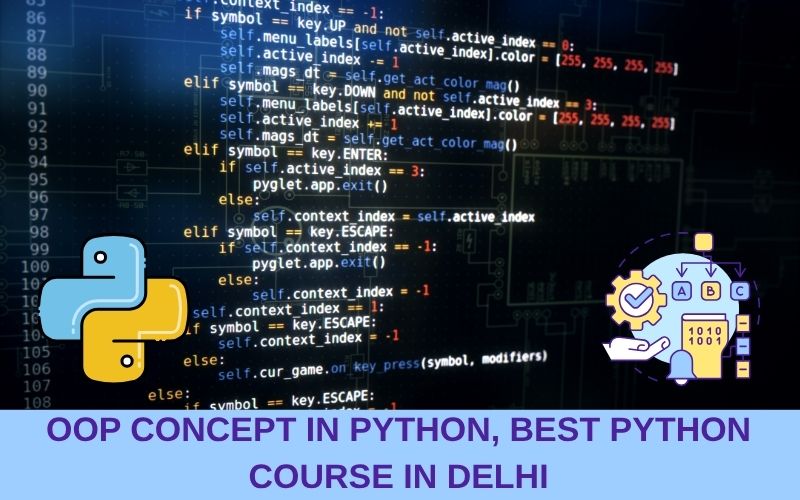Imagine you’re designing a game or an app. You don’t want to keep writing the same code again and again for every new character or page. You want a system where you can define one pattern, and reuse it — just like how you use a dress pattern to stitch multiple outfits. That’s where OOP (Object-Oriented Programming) comes in. It lets you create templates (called “classes”) for real-world things (like a car, student, or product), and then make actual examples (called “objects”) from them.
Object-Oriented Programming (OOP) is a coding style where data and behaviour travel together as objects created from classes. Think of a class as a house blueprint and each object as an actual house built from it. In Python, everything—int, list, even a function—is technically an object, which makes the language feel naturally OOP-friendly.
Real-Life Example:
If you have a class called Car, you can create multiple car objects like car1, car2, each with different colours, brands, etc. Instead of repeating the logic, you write it once in the class, and reuse it for all cars.
Why do developers swear by it?
- Reusability – Write once, reuse everywhere via classes and inheritance.
- Scalability – Big projects (Django back-ends, Pygame shooters) stay organised because related logic is bundled.
- Security – Encapsulation hides internal data so random code can’t mutate it.
Python layers its own goodies on top: magic methods, dataclasses, and a relaxed “duck typing” spirit that lets different objects share the same interface without strict type hierarchies. All of this means you spend less time fighting syntax and more time shipping features.
Classes & Objects Explained—with Example
Think of a class like a recipe for a cake. It has ingredients (data) and steps (functions). But the recipe itself isn’t a cake — it’s just instructions. When you actually bake a cake using that recipe, that’s an object. So one recipe (class), many cakes (objects) — each possibly with different flavours (data).
A class defines attributes and methods; an object is an actual instance. Real-life analogy: Car class vs. your specific red Wagon R parked outside.
class Car:
def __init__(self, brand, colour):
self.brand = brand
self.colour = colour
def honk(self):
return f"{self.brand} says Beep!"
w1 = Car("WagonR", "Red")
print(w1.honk()) # WagonR says Beep!Here brand and colour are data, honk() is behaviour. Because every Python class is itself an object (of type type), you can dynamically add attributes, inherit, or even create classes at runtime—handy for plug-in architectures.
Real-Life Use:
In web development, a User class can represent every person registered on your app. Each new signup creates a new User object, but all users share the same basic structure — name, email, password, etc.
Where it shows up:
Django Models are classes mapping directly to database tables. When you call User.objects.create(), Django is instantiating objects that later become SQL rows—OOP meets ORM magic.
Bottom line: mastering classes/objects is step #1 before wrestling with deeper oops concepts in python with examples like inheritance and polymorphism.
Encapsulation in Python
Ever used a TV remote? You don’t need to know how it works inside — you just press buttons and it does the job. That’s the idea behind encapsulation. You hide the messy stuff inside, and only show what’s necessary outside.
Encapsulation is the art of hiding messy internals and exposing a clean API. Python has no true private keyword, but the double-underscore naming convention (__balance) triggers name-mangling that keeps casual snoopers away.
class BankAccount:
def __init__(self, opening=0):
self.__balance = opening # “private” attribute
def deposit(self, amt):
self.__balance += amt
def get_balance(self):
return self.__balance
Why bother?
- Data integrity – Customers can’t directly set __balance = 1e9.
- Maintenance – You swap internal logic (say, add logging) without breaking callers.
- Security – Perfect fit for fintech or health-care modules where state must be guarded.
Interviewers love asking: “Python mein private kaise banate ho?” Answer: use a single underscore for “internal use” and double underscore for name-mangling; combine with properties (@property) to create read-only or computed attributes.
In finance apps, you don’t want users to directly change their bank balance. The app’s class methods (like deposit/withdraw) control how balances are updated safely, thanks to encapsulation.
Inheritance—Reusing While Extending
You inherit things from your parents — maybe height, habits, or skills. In coding, classes can also inherit traits from other classes. So instead of rewriting the same thing, you extend or reuse it. It saves effort and keeps your code neat.
Inheritance lets a child class grab everything from a parent and add/override behaviour. Simple demo:
class Vehicle:
def move(self): print("Moving…")
class Bike(Vehicle):
def ring(self): print("Tring-Tring!")inheritance—powerful but dangerous if you don’t understand Method Resolution Order (MRO). That’s why the community mantra is “prefer composition over inheritance once your tree gets deep.”
Real-world Python:
- Django CBVs (Class-Based Views): ListView < GenericView < View. You override only bits you need.
- Flask-RESTful: Resource subclasses implement HTTP verbs (get, post).
In Django, you might have a base class User and extend it into Customer, Admin, or Vendor, each with extra behaviour but all inheriting the basics like email, login, etc.
Interview angle:
Explain MRO in 30 seconds. Describe the C3 linearisation algorithm and show Class.__mro__ output to illustrate lookup order.
Polymorphism & Abstraction in python
Let’s say you have different types of employees — designers, developers, marketers. All of them “work,” but how they work is different. Still, you can call employee.work() on any of them and get results. That’s polymorphism — same command, different results.
Abstraction is like driving a car — you press the brake but don’t need to know how hydraulic systems work. Just use the interface.
Polymorphism is a fancy word for “functions that work on different object types.” Classic duck-typing:
def start_transport(vehicle): # any object with .move() passes
vehicle.move()
start_transport(Bike())
start_transport(Car("Honda", "Blue"))
No strict interfaces—if it quacks (move()), it flies.
Abstraction, meanwhile, hides complexity behind a higher-level concept—often implemented via Abstract Base Classes (ABCs):
from abc import ABC, abstractmethod
class PaymentGateway(ABC):
@abstractmethod
def pay(self, amount): ...
class Razorpay(PaymentGateway):
def pay(self, amount):
print(f"Paid ₹{amount} via Razorpay")Why they matter:
- Flexible code – Swap Stripe for Razorpay without touching checkout flow.
- Testability – Mock the abstract base in unit tests.
- Clean interviews – When asked “Give real-life application of abstraction,” talk payment gateways, logging interfaces, or storage back-ends (local, S3, GCP).
In an online payment system, whether you use Paytm, Razorpay or Stripe, your app just calls payment.process(). Each payment gateway class processes it differently but the outer code remains clean — that’s abstraction and polymorphism together.
Python OOP Interview Questions and Answers
OOP is a coding paradigm where objects — instances of classes — hold both data (variables) and behaviour (methods). Python supports OOP natively: everything in Python is an object — even integers and functions.
OOP makes code more modular, reusable, and scalable — especially useful for large apps or collaborative projects. Python makes it easy to write OOP-style code due to:
Clean, minimal syntax
Built-in support for classes, inheritance, and polymorphism
Dynamic typing and duck typing that remove boilerplate
__new__ creates the object (low-level); __init__ initialises it. Typically override only __init__.
Python resolves methods left-to-right using C3 linearisation (Class.__mro__). Prevents diamond conflicts
Class method receives cls and can spawn new instances; static method is namespaced utility—no self/cls.
Use double underscore for name-mangling (self.__secret). Combine with @property for read-only access.
Shallow copies references; deep copy recursively duplicates nested objects (copy.deepcopy).
Decorator that autogenerates dunder methods, type-annotated, ideal for data-centric classes
If relationship is has-a not is-a or when hierarchy >1 level deep; composition avoids fragile base-class problem.
Memorise these answers and you’re ready for most oops concepts in python interview questions
Pitfalls & Best Practices
- Over-inheritance – Three-level hierarchies look fancy but break fast; favour composition.
- Global state – Hide data inside objects, not module-level variables.
- Forgotten self – Every instance method needs it; linters help but muscle memory matters.
- Mutable class variables – Define mutable stuff inside __init__, else all objects share it.
- Missing __repr__ – Good repr speeds debugging: return f”<User {self.id}>”.
Python-Specific OOP Features
Sometimes, writing code feels like filling long boring forms — repeat this, write that, again and again. But Python makes your life easier with shortcuts and features that help you write less and do more. Think of it like getting auto-fill while doing an online payment. That’s what Python’s built-in OOP tools do for developers.
Python provides extra OOP tools beyond the classic four concepts (encapsulation, inheritance, etc.) to make your classes more powerful and concise.
- Magic (Dunder) Methods
These are special methods with double underscores (e.g., __init__, __str__, __len__, __add__) that let you define how your object should behave with operators or built-in functions.
class Book:
def __init__(self, title):
self.title = title
def __str__(self):
return f"Book: {self.title}"
print(str(Book("Ramayan")))- @dataclass Decorator
Saves you from writing repetitive __init__, __repr__, etc., for classes that mainly store data.
from dataclasses import dataclass
@dataclass
class Product:
name: str
price: float
- Mixins
Mini classes that add reusable functionality to other classes without affecting their main purpose (e.g., TimestampMixin, SoftDeleteMixin). - Metaclasses
Advanced tool to control class creation. Django ORM uses metaclasses to auto-register models.
Level-Up with ESS Institute’s Python course institute in Dwarka, Delhi
Whether you’re scouting a python course in delhi or need a weekend-friendly python course institute in Dwarka, Delhi ESS Institute’s curriculum starts with these OOP foundations and rockets into Django, REST APIs, and Pandas. Too far? Plug into our best Python course in Hindi online—live sessions + lifetime recordings + mentor support.
From classes to magic methods, you’ve now walked through every major OOP pillar with concrete Python examples and interview-ready answers. Apply them in a mini project this weekend, keep that PDF handy, and when you’re ready for mentor-guided mastery, you know where to reach us. Happy coding!

